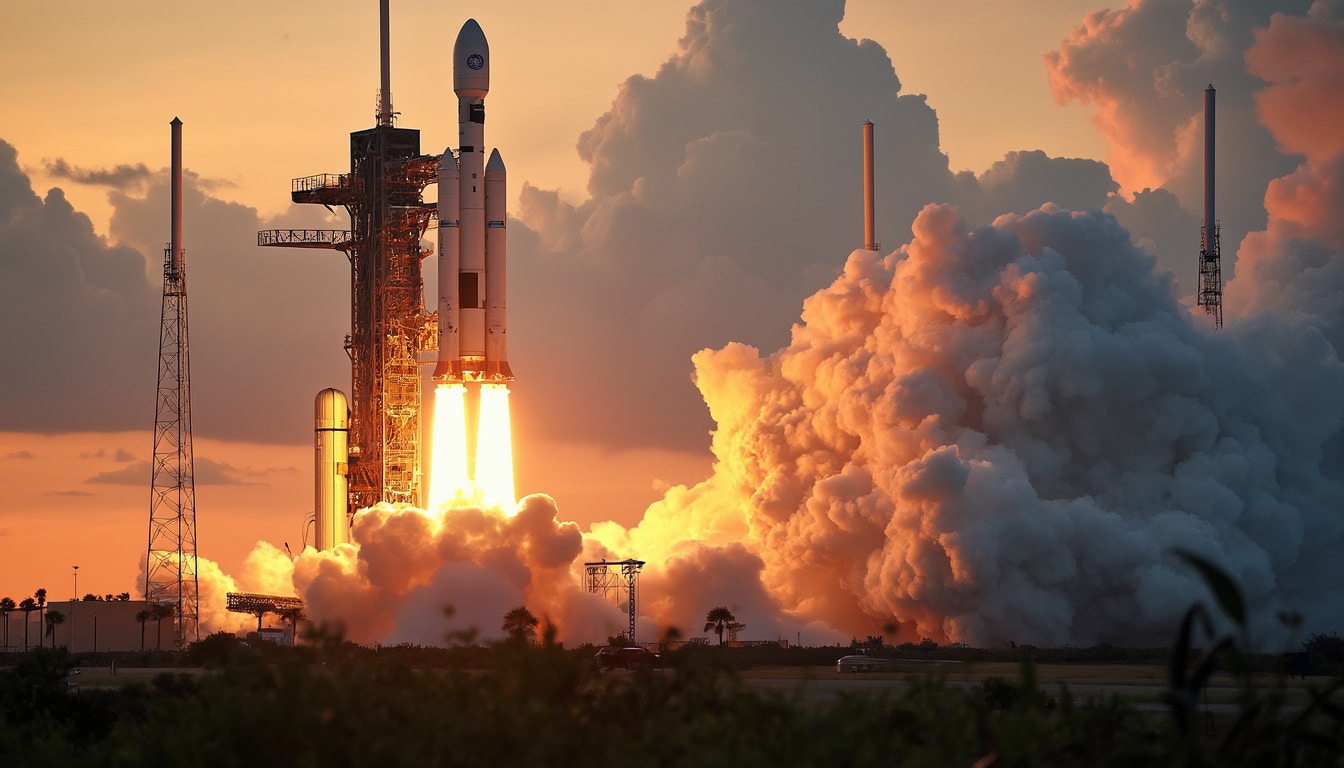The recent SpaceX mission, known as Bandwagon-3, marked a significant milestone as it celebrated the 300th orbital launch from Cape Canaveral’s Pad 40. Executed on April 21, 2025, this successful flight highlights the advanced capabilities of SpaceX and its role in the modern space race. Featuring a rideshare setup, the launch carried a variety of payloads into mid-inclination orbits, showcasing the versatile nature of the Falcon 9 rocket. As we delve deeper into this exciting mission, we’ll explore the key achievements, technological advancements, and what this milestone means for the future of space exploration.
This mission is not only a reflection of SpaceX’s continued success but also a testimony to the growing collaboration in the aerospace sector, which includes major players such as NASA, Blue Origin, and Lockheed Martin. The Falcon 9 rocket exemplifies the significant progress made in reusable rocket technology and its impact on reducing costs and enhancing access to space.
Celebrating a Milestone: Launch Details and Significance
At 8:48 p.m. EDT on April 21, 2025, SpaceX launched the Bandwagon-3 mission from the highly-respected Space Launch Complex 40. This event marked its 245th orbital launch from this particular site, underlining the importance and reliability of Cape Canaveral in the arena of space launches. The Falcon 9, tail-numbered B1090, achieved a flawless liftoff, demonstrating not just the prowess of its engineering, but also the efficiency of SpaceX’s operational framework. The first stage booster successfully landed at Landing Zone 2, a detail that speaks volumes about the advances made in rocket landing technology.

The Payloads on Board: A Diverse Mix of Scientific Innovation
The Bandwagon-3 mission was particularly noteworthy as it hosted a variety of payloads, including the fourth synthetic aperture radar (SAR) satellite for the Korea 425 Project. This mission is part of a broader initiative aimed at enhancing South Korea’s military surveillance capabilities. Notably, three of these satellites have all been launched via rideshare flights, forming a robust constellation for monitoring purposes that underscores the mission’s strategic significance.
In addition to the SAR satellite, the Falcon 9 payload also included Tomorrow Company Inc.’s Tomorrow-S7 satellite. This satellite represents another step forward in atmospheric measurement technologies, where it is expected to provide critical data on weather patterns and temperature profiles. The collaboration of Tomorrow.io with SpaceX demonstrates a growing trend of integrating commercial ventures into space missions.
One standout feature of this mission was the inclusion of Atmos Space Cargo’s Phoenix re-entry capsule. This innovative capsule aims to gather vital data regarding its inflatable heat shield, contributing to future developments in spacecraft design. The Phoenix 1 mission holds significant potential for reusable spacecraft solutions, aligning with SpaceX’s overarching goals for sustainability and efficiency.
The Technical Aspects Behind Reusability and Efficiency
An essential component of the Falcon 9’s success is its reusability, which has reshaped modern aerospace methodologies. SpaceX has become a pioneer in this field as it maximizes the lifecycle of each rocket. For instance, the booster used on this mission had already completed two previous flights, showcasing the robustness of its design and the technological advances in engineering.

The Economics of Space Launches
The economic implications of these advancements are profound. By reusing components of the Falcon 9, SpaceX has lowered the cost of access to space significantly. This has opened up new avenues for various commercial interests, not just for governmental organizations such as NASA but also for private companies looking to engage in space research and satellite deployment.
On the international stage, the implications are equally noteworthy. Companies like Boeing, Northrop Grumman, and Rocket Lab are adapting their own strategies, illustrating that competition in the aerospace sector is intensifying. The emergence of these players encourages innovation and leads to an overall benefit for space exploration initiatives.
As we look at the launching landscape in light of SpaceX’s Bandwagon-3 mission, we also see traditional agents such as Arianespace and Sierra Nevada Corporation being compelled to rethink their business models. From cost reduction strategies to enhancing reliability, the industry is evolving rapidly to keep pace with the constant technological improvements within the sector.
The Future of Space Collaboration: A Collective Effort
The milestone achieved by SpaceX symbolizes more than just technical feats; it embodies the spirit of collaboration that is increasingly vital for future missions. By joining forces with international collaborators, SpaceX is setting the stage for significant advancements in the exploration of outer space. The rise of partnerships among diverse organizations, such as NASA, Blue Origin, and other universities and commercial partners, is leading to innovative projects that extend far beyond mere satellite launches.
Preparing for Future Missions and the Artemis Program
Looking forward, the Bandwagon-3 success does not only enhance SpaceX’s reputation but also strengthens its role in future endeavors connected to NASA’s Artemis program, which aims to return humans to the Moon. As SpaceX prepares to support lunar landings, the efficacy demonstrated in missions like Bandwagon-3 will be incredibly beneficial. Collaborations with companies like Virgin Galactic and ongoing advancements in launch capabilities will bolster the push towards Mars and other planetary explorations.
The combined efforts in this competitive environment foster a spirit of determined coexistence, pushing boundaries through shared knowledge and capabilities. Stakeholders and investors alike are keeping a keen eye on how these contributions will shape not only their businesses but also humanity’s endeavors in space exploration.
Reflections and Insights into Our Cosmic Future
The success of SpaceX’s Bandwagon-3 mission is a momentous occasion in the history of space exploration. As we reflect on the achievements that have brought us to this pivotal moment, it is essential to acknowledge the individuals and organizations that continue to drive innovation forward. The collaborative efforts across national borders are essential in realizing aspirations that were once confined to the realm of science fiction.

The Role of Public Interest and Support
Public interest plays a crucial role in the success of these missions, and with each successful launch, more individuals become invested in our cosmic future. The conversations surrounding space exploration and the potential for lives to be changed through technological advancements are expanding. Outreach efforts from organizations like NASA and companies like SpaceX provide valuable insights for future generations to realize their dreams of space travel. Engaging the younger audience with programs that encourage education in STEM subjects will plant the seeds for the next generation of innovators and explorers.
As we contemplate the legacy of SpaceX’s Bandwagon-3 mission, we stand on the brink of a new era in both technology and human exploration. The milestones achieved bring with them the promise of exciting advancements and discoveries. All eyes will be on upcoming missions and the potential impact they will have on our understanding of the universe.
For those interested in further details and the latest updates on future missions, resources like Spaceflight Now offer comprehensive coverage, while Space Launch Schedule provides key insights into forthcoming launches.




Leave a Reply